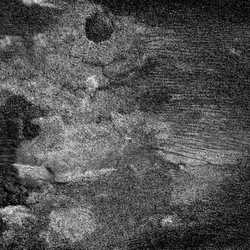
Shikoku Facula region on Titan. Image credit: NASA/JPL/SSI. Click to enlarge
Cassini recently swept past two previously unexplored regions of Titan, and returned radar images of its surface. Cassini made its flyby on April 30, targeting the Xanadu region – one of the most prominent features on Titan, which is even visible from Earth. It revealed strange curving features that could indicate flowing fluids. There are also two large craters that could be from meteor impacts or volcanic calderas. This was Cassini’s 14th Titan flyby, with the next on May 20.
Saturn’s moon Titan continued to surprise scientists during a flyby that took Cassini into regions previously unexplored by radar. Two very noticeable circular features, possible impact craters or calderas, appear in the latest radar images taken during the flyby on April 30, 2006.
The flyby targeted Xanadu, one of the most prominent features on Titan, visible even from telescopes on Earth. The origin of Xanadu is still unknown, but the radar images reveal details previously unseen, such as numerous curvy features that may indicate fluid flows. Scientists speculate that two prominent circular features are probably impact craters but they don’t rule out the possibility that they might be calderas or volcanoes. Sand dunes, discovered in previous flybys, continue to crisscross Titan’s surface.
Communication from the spacecraft was temporarily interrupted for nearly five hours during the data playback following the flyby. The most important science data from the flyby were protected by a contingency plan put in place in advance of the flyby. The flight team believes the outage was likely due to a galactic cosmic-ray hit on a power switch in the spacecraft communications subsystem. The anomaly resulted in the loss of some science data. However, the spacecraft is now performing normally.
This was the 14th Titan flyby for Cassini, with nine more remaining this year. The next will be May 20, 2006. During the nominal four-year mission Cassini will perform 45 Titan flybys.
The Cassini-Huygens mission is a cooperative project of NASA, the European Space Agency and the Italian Space Agency. JPL, a division of Caltech, manages the mission for NASA’s Science Mission Directorate. The Cassini orbiter was designed, developed and assembled at JPL.
For images and more information, visit: http://www.nasa.gov/cassini and http://saturn.jpl.nasa.gov .
Original Source: NASA/JPL/SSI News Release
